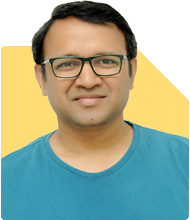Should I Retire Early at 49 with 1.1 Crore?
Ramalingam Kalirajan |8291 Answers |Ask -Follow
Mutual Funds, Financial Planning Expert - Answered on Feb 04, 2025
He has an MBA in finance from the University of Madras and is a certified financial planner.
He is the director and chief financial planner at Holistic Investment, a Chennai-based firm that offers financial planning and wealth management advice.... more

Dear Sir/Madam I am 49 and in HR senior position. To take care of my health and well being i want to retire by max next year after my son passes 12th Commerce & start college. I have liquid money along with various FDs of around Rs 1.10 Crores. PF and gratuity now around Rs 27 lakhs. Additionally i have a rental income of around 22k per month. Stock market investment of around Rs 4 lakhs. I have no loans however pay a LIC premium of Rs 60 k every year till 60 yrs age of a 10 lakhs policy. I have health insurance policy of 15 lakhs of premium Rs 40 k per year. Hope i can go for early retirement next year. Kindly advice
Your PF and gratuity are Rs. 27 lakhs combined.
Rental income of Rs. 22,000 per month is a steady cash flow.
Stock market investments total Rs. 4 lakhs.
There are no loans, which is commendable for early retirement planning.
You hold a LIC policy of Rs. 10 lakhs with Rs. 60,000 annual premium till age 60.
Health insurance with Rs. 15 lakh coverage is excellent.
Emergency Fund Planning
Set aside at least Rs. 10 to 15 lakhs for emergencies.
Keep this fund in a liquid mutual fund or high-interest savings account.
This will protect you from dipping into other investments during crises.
Health and Life Insurance Review
Your Rs. 15 lakh health insurance coverage is adequate for now.
Review the policy annually to ensure it covers lifestyle illnesses.
Consider adding top-up health insurance if your insurer offers it.
Your LIC policy with Rs. 10 lakh coverage is insufficient for life protection.
It may be wise to surrender this policy and reinvest in mutual funds.
Opt for a term insurance plan if life coverage is still needed.
Retirement Corpus Planning
Your current corpus stands at Rs. 1.41 crores, including PF and gratuity.
This corpus needs to be carefully invested for a stable income.
Allocate your funds as follows:
60% in Balanced Hybrid Mutual Funds: These offer stability and growth.
20% in Debt Mutual Funds: Lower risk and steady returns.
15% in Equity Funds: For inflation-beating long-term returns.
5% in Gold Funds or Sovereign Gold Bonds: Hedge against market volatility.
Avoid index funds, as they underperform in volatile markets.
Actively managed funds by experienced professionals deliver better returns.
Monthly Income Strategy
You need a monthly income to support expenses post-retirement.
Your rental income of Rs. 22,000 is a reliable source.
Invest part of your corpus in mutual funds for a Systematic Withdrawal Plan (SWP).
SWPs can provide a stable income while keeping your investments growing.
Avoid annuities, as they lock your money and offer lower returns.
Stock Market Strategy
Your Rs. 4 lakh stock market investment is a good starting point.
Avoid risky direct stock investments unless you have expertise.
Invest through regular mutual funds managed by professionals.
Invest through a Certified Financial Planner (CFP) for tailored advice.
Estate Planning
Prepare a detailed will to ensure smooth asset transfer.
Include details of FDs, PF, rental property, and mutual fund investments.
Appoint a trustworthy executor for your estate.
Final Insights
You are well-prepared for early retirement with thoughtful planning.
Building a diversified portfolio will ensure financial stability.
Focus on health insurance, disciplined investments, and estate planning.
Seek ongoing advice from a Certified Financial Planner (CFP) for expert guidance.
Best Regards,
K. Ramalingam, MBA, CFP
Chief Financial Planner
www.holisticinvestment.in
https://www.youtube.com/@HolisticInvestment
You may like to see similar questions and answers below
Ramalingam Kalirajan |8291 Answers |Ask -Follow
Mutual Funds, Financial Planning Expert - Answered on May 28, 2024
Ramalingam Kalirajan |8291 Answers |Ask -Follow
Mutual Funds, Financial Planning Expert - Answered on Jul 10, 2024
Ramalingam Kalirajan |8291 Answers |Ask -Follow
Mutual Funds, Financial Planning Expert - Answered on Dec 03, 2024
Dr Nagarajan Jsk |346 Answers |Ask -Follow
NEET, Medical, Pharmacy Careers - Answered on Apr 25, 2025
Nayagam P P |4463 Answers |Ask -Follow
Career Counsellor - Answered on Apr 25, 2025
Nayagam P P |4463 Answers |Ask -Follow
Career Counsellor - Answered on Apr 25, 2025
Nayagam P P |4463 Answers |Ask -Follow
Career Counsellor - Answered on Apr 25, 2025
Patrick Dsouza |1030 Answers |Ask -Follow
CAT, XAT, CMAT, CET Expert - Answered on Apr 25, 2025
Dr Dipankar Dutta |1168 Answers |Ask -Follow
Tech Careers and Skill Development Expert - Answered on Apr 25, 2025
Dr Dipankar Dutta |1168 Answers |Ask -Follow
Tech Careers and Skill Development Expert - Answered on Apr 25, 2025
Dr Dipankar Dutta |1168 Answers |Ask -Follow
Tech Careers and Skill Development Expert - Answered on Apr 25, 2025
Radheshyam Zanwar |1566 Answers |Ask -Follow
MHT-CET, IIT-JEE, NEET-UG Expert - Answered on Apr 25, 2025
Radheshyam Zanwar |1566 Answers |Ask -Follow
MHT-CET, IIT-JEE, NEET-UG Expert - Answered on Apr 25, 2025






















